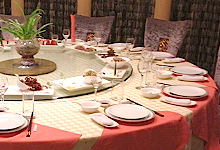for private and business using
Categories History
History

Rotary glass plates - tradition and modernity from the Far East
Community, company and comfort tie the concept of a rotary plate on the table to Asian traditions and a new way of hospitability … a new way? Not at all: The concept is hundreds of years old and yet more in fashion than ever.
With a rotary plate, smaller dishes, side dishes, different dressings or sauces are in reach of everyone at the table - in a comfortable atmosphere! Centuries ago it has already been common knowledge in the Far East that diversity is joined with a better community, better company, only if everybody can equally experience the sociability at the table.
Did you know that according to Asian traditions, the hosts can honour their guests and show them appreciation in a very easy way? Asian traditions allocate this to a rotary plate that requires nobody to rise from the seat or ask for more. Everybody can very simply help themselves at the dishes.
Wooden rotary plates have been used in earlier times. This has changed, hygiene obliges, and rotary plates made of glass are now preferred … of course made of very high-quality and enormously heat-resistant shatterproof glass.
Traditionally, the rotary glass plate can be decorated with Far Eastern motives or be simple and modern. We offer both designs, of course - it is your taste that decides, after all.
The traditional use of the rotary glass plate:
Nobody wants to dictate how you should use our rotary glass plate - no, we won't do so, either. Yet we would like to give a few hints on how a rotary plate is traditionally used in Asia and which rules are followed there … how to transfer this tradition to a great dinner in your home is up to you, of course:
After all dishes, additions and ingredients were placed on the rotary glass plate, a host opened the meal with an hors-d'oeuvre or a small dish by turning the rotary glass plate to one of the guests and asking to take first from the provided dishes.
The first guest does as invited, turns the rotary glass plate clockwise and asks the next guest to do the same.
Once you have helped yourself, the rotary glass plate is turned gradually clockwise in the direction of the next neighbour.
Move the rotary plate carefully and gradually, otherwise soups or other dishes might slop over.
If others help themselves, nobody should try to turn the rotary glass plate further. Patience and respect for the neighbour are the essence of community … and nobody has to interrupt the conversation to ask for a dish, an addition or ingredient … just turn! And did you know this: Turning counterclockweise and clockwise again violates the Far Eastern tradition because it suggests restlessness.
You may have noticed during your first dinner how much harmony is introduced to your table when you use a rotary glass plate according to the Far Eastern tradition. Even if you have no guests at home and want to enjoy a diversified dinner for two only.
In any case, there is an easy way how to make a common dinner more harmonious and convenient and express community at the table - according to the Asian everyday tradition.





